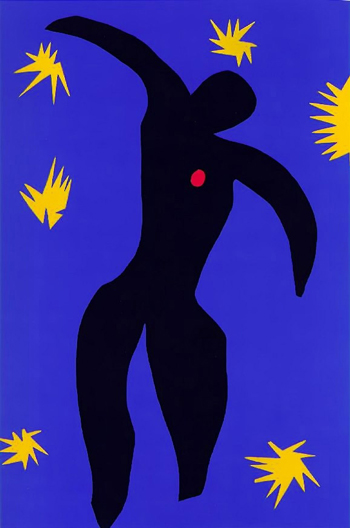| Search Art Prints | ||||||||||||||||||||
| Search Artists | ||||||||||||||||||||

|
||||||||||||||||||||
|
|
|||||||||||||||||||

Jazz Icarus

|
Matisse's Icarus is a neo-Impressionist take on a subject favored by European painters since the Renaissance: Icarus's plunge from the sky into the sea. In reality a mixed-media work rather than a painting, Matisse painted an effervescent blue background on which he placed cut-out images of Icarus and the surrounding stars.
Here, Icarus is depicted with a prominent, brilliant red heart. This symbolizes his passion, supplanting the hybris of the original myth as the cause of his disastrous fall. The abstracted act of falling also further emphasizes the symbolism of the myth: rather than depict a literal fall, Matisse alludes to a languid, despairing plunge, closer to the tragic defeat that Icarus's fall represents. With techniques such as these, Matisse grounds the myth of Icarus more in the everyday. Indeed, Icarus's passion and corpse-like posture powerfully evoke the folly of the ambitious artist and his inevitable failure to attain his lofty goals.
Mattise's execution of the work is crucial to its strength. He painted the blue sky background with wide brush strokes, using tones of light to medium blue. The result is an airy, light, ethereal backdrop on which the brilliant light of the stars and the stark blackness of Icarus's figure can be placed. The objects stand against the blue with a stark contrast that is truly remarkable. The catastrophic nature of the fall is underscored by this contrast and the simple construction: there is nothing to cover or mute the tragedy of the moment. Though Matisse also painted the similar The Fall of Icarus around the same time, this remains the more famous and more powerful image.











